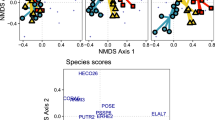Abstract
The paradigm in prairie ecology is that fire is one of the key factors determining vegetation composition. Fire can impact grassland ecosystems in various ways, including changing plant species composition and inducing nitrogen loss. I found that 17 years of different burning frequencies in infertile grassland had only a minor impact on the vegetation composition and diversity. The only major impact from increasing the frequency of fires was a decrease of Poa pratensis abundance. However, other plant species did not respond to the change in Poa abundance. This result contrasts with previous studies in savannas and more productive grasslands, where the balance between trees, grasses, and the elimination of the litter layer can result in large vegetation changes. However, in this system primary productivity was low, litter did not accumulate and no major vegetation shifts occurred. Thus, the long-term vegetation impacts of burning in an infertile, low-productivity prairie were minimal.



Similar content being viewed by others
References
Blair JM (1997) Fire, N availability, and plant response in grasslands: a test of the transient maxima hypothesis. Ecology 78:2359–2368
Briggs JM, Knapp AK (1995) Interannual variability in primary production in tallgrass prairie: Climate, soil moisture, topographic position, and fire as determinants of aboveground biomass. Am J Bot 82:1024–1030
Collins SL, Gibson DJ (1990) Effects of fire on community structure in tallgrass and mixed-grass prairie. In: Collins SL, Wallace LL (eds) Fire in North American tallgrass prairie. University of Oklahoma Press, Norman, pp 81–98
Collins SL, Knapp AK, Briggs JM, Blair JM, Steinauer EM (1998) Modulation of diversity by grazing and mowing in native tallgrass prairie. Science 280:745–747
Engle DM, Bultsma PM (1984) Burning of Northern mixed prairie during drought. J Range Manage 37:398–401
Foster BL, Tilman D (2000) Dynamic and static views of succession: testing the descriptive power of the chronosequence approach. Plant Ecol 146:1–10
Gibson DJ (1988) Regeneration and fluctuation of tallgrass prairie vegetation in response to burning frequency. Bull Torrey Bot Club 115:1–12
Grigal DF, Chamberlain LM, Finney HR, Wroblewski DW, Gross ER (1974) Soils of the cedar creek natural history area. University of Minnesota Agriculture Experiment Station, St. Paul
Haddad NM, Tilman D, Knops. JMH (2001) Long-term oscillations in grassland productivity induced by drought. Ecol Lett 5:110–120
Hartnett DC, Hickman KR, Fisher Walter LE (1996) Effects of bison grazing, fire and topography on floristic diversity in tallgrass prairie. J Range Manage 49:413–420
Inouye RS, Huntley NJ, Tilman D, Tester J, Stillwell M, Zinnel K (1987) Old-field succession on a Minnesota sand plain. Ecology 68:12–26
Knapp AK, Briggs JM, Hartnett DC, Collins SL (1998) Grassland dynamics. Long-term ecological research in tallgrass prairie. Oxford University Press, New York
Knapp AK, Seastedt TR (1986) Detritus accumulation limits productivity in tallgrass prairie. Bioscience 36:662–668
Knops JMH, Tilman D (2000) Dynamics of soil carbon and nitrogen accumulation for 61 years after agricultural abandonment. Ecology 81:88–98
Leach MK, Givnish TJ (1996) Ecological determinants of species loss in remnant prairies. Science 273:1555–1558
Magurran AE (1988) Ecological diversity and its measurement. Princeton University Press, Princeton
Ojima DS, Schimel DS, Parton WJ, Owensby CE (1994) Long- and short-term effects of fire on nitrogen cycling in tallgrass prairie. Biogeochemistry 24:67–84
Peterson DW, Reich PB (2001) Fire frequency and stand dynamics in an oak savanna-woodland ecosystem. Ecol Appl 11:914–927
Redman RE (1978) Plant and soil water potentials following fire in a Northern mixed grassland. J Range Manage 31:443–445
Reich PB, Peterson DW, Wedin DA, Wrage K (2001) Fire and vegetation effects on productivity and nitrogen cycling across a forest-grassland continuum. Ecology 82:1703–1719
Smith MD, Knapp AK (1999) Exotic plant species in a C4-dominated grassland: invasibility, disturbance, and community structure, vol 120, pp 605–612
Steuter AA (1987) C3/C4 production shift on seasonal burns—Northern mixed prairie. J Range Manage 40:27–31
Tester JR (1996) Effects of fire frequency on plant species in oak savanna in east-central Minnesota. Bull Torrey Bot Club 123:304–308
Tilman D (1984) Plant dominance along an experimental nutrient gradient. Ecology 65:1445–1453
Tilman D (1987) Secondary successional and the pattern of plant dominance along experimental nitrogen gradients. Ecol Monogr 57:189–214
Tilman D (1990) Constraints and tradeoffs: toward a predictive theory of competition and succession. Oikos 58:3–15
Tilman D, Wedin D (1991) Plant traits and resource reduction for five grasses growing on a nitrogen gradient. Ecology 72:685–700
Towne EG, Knapp AK (1996) Biomass and density reponses in tallgrass prairie legumes to annual fire and topographic position. Am J Bot 83:175, 179
Towne G, Owensby CE (1984) Long-term effects of annual burning at different dates in ungrazed Kansas tallgrass prairie. J Range Manage 37:392–397
Wan S, Hui D, Luo Y (2001) Fire effects on nitrogen pools and dynamics in terrestrial ecosystems: a meta-analysis. Ecol Appl 11:1349–1365
Wedin DA, Tilman D (1996) Influence of nitrogen loading and species composition on the carbon balance of grasslands. Science 274:1720–1723
Acknowledgements
This research has been supported by the University of Nebraska and NSF grants 0080382, 0087206 and 0100133. Thanks are due to Troy Mielke and the Cedar Creek interns for help in the field, and Amy Symstad, Kate Bradley, Ramesh Laungani, Cathleen McFadden and Kate Stoysich for comments.
Author information
Authors and Affiliations
Corresponding author
Additional information
Communicated by Alan Knapp.
Rights and permissions
About this article
Cite this article
Knops, J.M.H. Fire does not alter vegetation in infertile prairie. Oecologia 150, 477–483 (2006). https://doi.org/10.1007/s00442-006-0535-8
Received:
Accepted:
Published:
Issue Date:
DOI: https://doi.org/10.1007/s00442-006-0535-8




